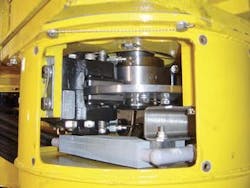Multi-purpose brakes for vessels, drilling operations
Anew stopping, turning, and locking system from Dellner Brakes provides controlled turning of propeller shafts during maintenance. The system, known as STL-modular, is being supplied to four anchor handling tug supply (AHTS) vessels under construction in China.
STL-modular performs three functions:
* Stopping - the propeller shaft is stopped by hydraulic disc brakes
* Turning - the shaft is turned to the required position using mechanical linkages with a hydraulic cylinder
* Locking - the shaft is locked in position by a plunger, which is inserted in a slot in the brake disc.
For the first time, the customer gets one STL system that can handle all three operations with one interface, says managing director Niklas Jonsson. And as it is a modular system, the customer has the choice of buying the locking unit, the locking and turning system, or the brake either as individual components or integrated into a full STL system.
The company is a leading supplier of hydraulic caliper disc brakes for industrial applications. It started hydraulic disc brake production in 1965 and has traded as Dellner Brakes since 1998. The company is certified to the ISO 9001:2000 standard. All products are assembled at its headquarters in Falun, Sweden.
The three main sectors it supplies are offshore, marine - including many offshore vessels - and crane manufacture. Offshore and marine products are mainly stop-and-hold brake systems for propellers and steering equipment, and holding/emergency brakes for winches and drilling-rig drawworks. All exposed metal parts of the offshore products are made from stainless steel.
High engineering input
More than 50% of the company’s orders are project-related, so it is more accurate to say that it supplies systems involving a significant engineering input rather than just products, Jonsson says. Of the company’s employees, 70% are qualified engineers.
Dellner Brakes’ SKP spring-applied disc brakes offer a reliable and safe method of braking a linear or rotating movement. The standard brakes consist of two symmetrical brake halves, each of which is supplied with two cylindrical guiding pins which transmit the tangential braking force from the brake lining to the brakes. This means that the brake piston is not subjected to any radial forces, thus contributing to a longer life for the brakes. The brake halves are provided with retracting springs which draw back the brake linings when braking pressure has been relieved.
To compensate for wear and tear of the brake lining, the disc spring stack has to be adjusted several times during the life span of the brake lining. This is a simple operation carried out with the aid of extra hydraulic cylinders supplied with the product.
The company’s SKD pressure-applied disc brakes are direct-acting and activated by hydraulic or pneumatic pressure. The braking power achieved is directly proportional to the applied pressure. The brake consists of two symmetrical brake halves and for the smaller models is designed for a brake disc thickness of 12 mm. If a thicker brake disc is required, the brakes are supplied with an interlayer.
As with the spring-applied brakes, the pressure-applied brakes are supplied with cylindrical guiding pins which transmit the tangential braking force from the brake lining to the brakes, and retracting springs which draw back the brake linings when the braking effect has been achieved. Deterioration in the brake lining is compensated for automatically through increased cylinder stroke of the piston.
294 kN brake
Dellner Brakes recently launched a new product which is applicable to winches and drawworks. This is the SKP 220, its largest and heaviest spring-applied brake, which weighs 410 kg and can apply a maximum braking force of 294 kN.
For 10 years the company has been a regular supplier to drill equipment manufacturers of its SKD 50 brake for use on top drives. The brake is used to hold back torque in the drill string in order to avoid the motor stalling and to assist with positioning the drill-bit during directional drilling. Two units are mounted on the motor shaft operating on a 305 mm diameter disc providing 3,800 Nm of torque with 100 bar applied hydraulic pressure. Through the gear reduction, the holding torque at the drillstring is 40 kNm.
Dellner Brakes has also supplied shaft brakes to four AHTS vessels owned by Mærsk Supply Service of the A P Møller group. Each propeller shaft is equipped with two SKD 4 x 100 pressure-applied caliper disc brakes operating on a 1,500 mm diameter disc. Hydraulic pressure for the brakes is supplied by a pneumatic-to-hydraulic pressure intensifier system. Each brake system develops torque of up to 284 kNm.
The company’s brake systems are also installed on Transocean’s semisubmersible drilling rigsSedco Express, Sedco Energy, and Cajun Express, all fitted with four electrically driven podded propulsion units. Every pod is equipped with a Dellner disc brake for stopping and holding the propeller shaft for maintenance operations.
Each brake system consists of two SKD 100 hydraulic pressure-applied disc brakes working on a 1,160 mm diameter disc and pressure intensifier system. The brakes are actuated with up to 150 bar of hydraulic pressure generated by the pneumatic-to-hydraulic intensifier system. The brake system produces up to 47 kNm of braking torque.
For more information, contact Niklas Jonsson, Dellner Brakes. Tel +46 2378 3051, fax +46 2377 0690, [email protected], www.dellner-brakes.com.

